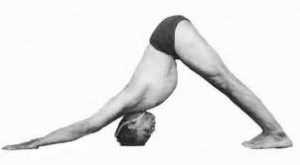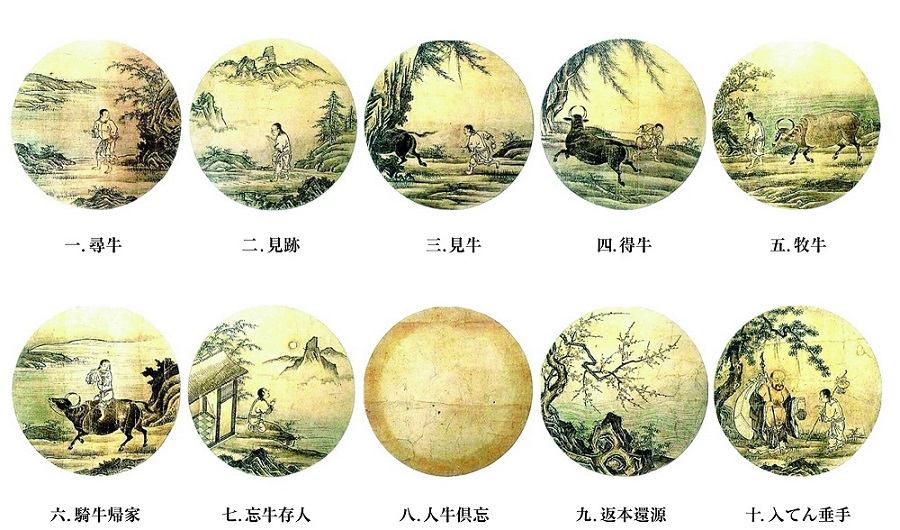Lesson 6: Dog Pose and Variations
Dog pose, known more formally in Sanskrit as adho mukha svanasana, downward facing dog pose, is one of the most important of all yoga postures, as it involves the hip action of a standing pose, the spinal action of a beginning back bend, and the arm and shoulder action of inversions. So for a beginning student, if offers a multiplicity of challenges and rewards.
We will begin with a variation I call wide dog, which is actually prasarita padottanasna from  the hips and legs, but dog pose in the torso. In this variation, the weight is carried much more by the legs, leaving the shoulders and arms to sort out the demand of the position without too much weight bearing. Do not sink in the armpits but lift them up slightly by pressing down on the hands. The shoulders and arms lengthen, along with the legs and spine. Also, as the hands try to push the mat forward as well, the rebound action can be taken at the top of the thigh bones at the hip
the hips and legs, but dog pose in the torso. In this variation, the weight is carried much more by the legs, leaving the shoulders and arms to sort out the demand of the position without too much weight bearing. Do not sink in the armpits but lift them up slightly by pressing down on the hands. The shoulders and arms lengthen, along with the legs and spine. Also, as the hands try to push the mat forward as well, the rebound action can be taken at the top of the thigh bones at the hip  sockets, deepening the opening of the groins. This will create the feeling of groin length and spinal release, as well as shoulder freedom. A great way to experience this space is in the hanging dog. If you do not have wall ropes, a long belt wrapped around both sides of a door knob will work
sockets, deepening the opening of the groins. This will create the feeling of groin length and spinal release, as well as shoulder freedom. A great way to experience this space is in the hanging dog. If you do not have wall ropes, a long belt wrapped around both sides of a door knob will work
When you have a strong sense of how the hips and shoulders can stay open, you are ready for the full down dog. You will be able to sense when the shoulders and groins are opening, and when they are contracted or collapsed.  Iyengar’s armspits and groins are Open! His chakra line is alive because of the intensity of the action in his legs. They are doing much more of the work than the arms. This is not so easily accomplished as most students under work the legs and over work their arms. A major reason is that they do not have a sense of a tail that they can access to open the muladhara and tap into that energy. Dogs, on the other hand, have a useful tail. Notice how this yoga dog is rising up from the pelvis though the tail energy. This creates a line for the lower spine to lengthen, something that humans have a major problem accomplishing. It also moves energy into the backs of the hips to complete the opening of the muladhara.
Iyengar’s armspits and groins are Open! His chakra line is alive because of the intensity of the action in his legs. They are doing much more of the work than the arms. This is not so easily accomplished as most students under work the legs and over work their arms. A major reason is that they do not have a sense of a tail that they can access to open the muladhara and tap into that energy. Dogs, on the other hand, have a useful tail. Notice how this yoga dog is rising up from the pelvis though the tail energy. This creates a line for the lower spine to lengthen, something that humans have a major problem accomplishing. It also moves energy into the backs of the hips to complete the opening of the muladhara.
As Mother Nature had other plans for the human tail, yoga students can use a leg to help discover their ‘imaginary’ tail and awaken the energy body ‘tail field’, the muladhara. We began this in ardha chandrasana and now our one legged dog takes on a new dimension. See the up leg as a reminder to elongate out through the inner heel, as if it were a tail. Feel that this action lifts weight off of the shoulders.
See the up leg as a reminder to elongate out through the inner heel, as if it were a tail. Feel that this action lifts weight off of the shoulders.
This leads to ‘flipping the dog’, where you rotate around, pivoting on the lower foot and dropping the upper leg as the same side arm comes up. Open the chest, release the neck and throat and let the head elongate as the top arm reaches into space. Then reverse to come back. The uplifting arm is the brain of the pose as its ascending lightness balances the weight and descent of the leg.
Open the chest, release the neck and throat and let the head elongate as the top arm reaches into space. Then reverse to come back. The uplifting arm is the brain of the pose as its ascending lightness balances the weight and descent of the leg.
In the contra-lateral dog pose, the upper limb drops slightly, as if coming into revolved half moon, and then the opposite arm lifts up. Try doing it with the back leg in full dog pose position. This will stimulate your corpus collosum, linking right and left hemispheres of the brain, as well as help bring stability. The pivot on the standing foot and slide the upper leg under the torso without letting it touch the floor. This move, invented by my friend Aaron Cantor, challenges flow and balance, but once you get it, you want more.


